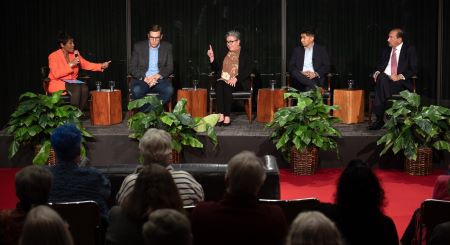Experts Call for Relieving Administrative Bottlenecks to Legal Immigration during "The Way Forward: Immigration Reform for the 21st Century"
 Immigration policy experts discussed challenges and called for attainable and long-term policy solutions associated with the US legal immigration system and unauthorized immigrants during a recent webinar hosted by the Center for Houston's Future, the George W. Bush Institute, and the Rice University Baker Institute Center for the United States and Mexico.
Immigration policy experts discussed challenges and called for attainable and long-term policy solutions associated with the US legal immigration system and unauthorized immigrants during a recent webinar hosted by the Center for Houston's Future, the George W. Bush Institute, and the Rice University Baker Institute Center for the United States and Mexico.
A key point of agreement among speakers was that the current outdated and inefficient legal immigration system not only hinders the US economy but also encourages illegal immigration.
David Bier, Research Fellow with the CATO Institute, explained that problems at the border are in many ways directly attributable to the current unprecedented labor shortage in the US with over 10.5 million open jobs and the lack of existing legal pathways for most people to come to the US and work.
“If you do not have a family member in the US, you are not going to be able to immigrate here unless you are a select few highly skilled individuals. There are a few seasonal visas that have done a great job of reducing illegal immigration from Mexico, but the fact that there is not a year-round work visa option for people to fill jobs at dairies, meat processing plants, and other industries that are desperately short of workers right now is ultimately the driving force behind the disaster we see at the border right now. Regardless of the motivations for people coming to the border, at the end of the day what finances all of that relocation are US jobs that immigrants will fill or have already filled and are sending funds for their family members,” said Bier.
“The fact that we have so many undocumented people is the product of a broken legal immigration system, and it’s true that migrants would much prefer to come legally. If we expand our legal immigration avenues and the capacity of our system to process it, we would have a lot smaller problem at the border,” added Theresa Cardinal Brown, Managing Director of Immigration and Cross-Border Policy with the Bipartisan Policy Center.
Bier also highlighted the fact that legal immigration and work travel to the US since 2020 has declined partially due to administrative procedures and bureaucratic inefficiencies, and how this is exacerbating current workforce shortages and their negative effects on the US economy.
“We have the H2B program for seasonal nonagricultural workers. Congress passed an immigration law in December of 2020 to double the visa cap for this program, another 64,000 visas there, and only 22,000 of them were issued, and intentionally so. That wasn’t a processing issue, they just said we don’t actually see the need for using all 64,000 visas. Given the record number of open jobs, that was an incredibly bizarre decision. Over the last year we’ve lost about 1.2 million adult work eligible temporary workers and permanent residents who could be contributing to our economy right now. If you look at the difference in unfilled jobs from before the pandemic which was 6 million, and now we are over 10 million, that’s about a quarter of the difference right there. Our economy is suffering from inflation and businesses are reducing hours and closing because they can’t find workers, and here we have this large labor pool that is not being tapped and it’s entirely due to administrative procedures not fulfilling laws that congress has already enacted,” said Bier.
Jeremy Robins, Executive Director of New American Economy, further highlighted the competitive advantage that immigrants bring to the US’ workforce and economy.
“There are 10,000 baby boomers retiring every day. The average age of Americans is shooting up, every census it gets higher. As we have more seniors who are living longer, there simply aren’t enough workers to support them…The fact that immigrants vote with their feet and come here to work has huge positive implications on our workforce,” said Robins, noting that about 60% of native born Americans are working age (16-64), but around 80% of immigrants are working age because people often come to the US to work.
Speakers also pointed out that the current lack of a viable method for unauthorized immigrants to earn legal status is a key reason that there are currently so many of them living in the shadows and working in the underground economy.
“Right now our system prioritizes punishment over rehabilitation, which ultimately perpetuates infractions into the future, encouraging immigrants to hide in the shadows rather than to step forward and correct mistakes. The main way in which our system encourages this right now is through a legal immigration system that is incredibly restrained and heavy penalties on people who violate immigration restrictions,” said David Bier, noting that Section 212(a)(9)(C)(i)(I) of the Immigration and Nationality Act prevents immigrants who have been in the US for more than one year without legal status from applying for status unless they leave the US for 10 years.
“This policy encourages illegal immigrants to remain in the shadows because 10 years is too long for people who have built their lives here to go back and be separated from their homes and families,” he added.
Calling for solutions, speakers stressed the needs for legal immigration changes that would improve legal pathways and help deter future illegal immigration. They also proposed several adjustments to current existing policies regarding legalization that could avoid complicated and politically difficult processes of drafting large and new programs through legislation.
“It’s important for us to be realistic about what is doable…We have not significantly expanded the capacity of our system in a very long time…We need to invest in the capacity of our immigration system to do its regular job and whatever we might do on a bigger scale. It’s important to focus on implementation. It’s no good to promise a benefit to people that you can’t deliver,” said Brown, highlighting the importance of investing resources into the legal immigration system so that it can process cases efficiently, while also noting that immigration bills related to workforce and reforming the legal immigration system tend to garner the most bipartisan support in Congress.
Speakers called for a removal of the 10 year bar that prevents unauthorized immigrants from applying for status unless they leave for ten years, and the creation of a currently non-existent statute of limitations on immigration violations that would allow unauthorized immigrants the chance to earn legal status after certain number of years pass. In addition, they called for a relatively simple tweak to the Immigration and Nationality Act Section 245 (i) that would allow somebody that already has eligibility for legal status, but for their unauthorized status, the ability to access it, be it with a fine or penalty.
They also expressed support for immigration measures included in the House’s budget reconciliation bill that would allow for many unauthorized immigrants to apply for temporary legal status, noting that it would bring immediate economic and fiscal benefits and help alleviate the current workforce shortage. However, speakers noted that in failing to address the legal immigration system’s shortfalls, the immigration policies within the budget reconciliation fall short of providing long-term solutions to address challenges associated with future legal and illegal immigration.
“What happens in reconciliation will be remediation, not reform, and we need reform,” said Brown.
To learn more, check out the full "The Way Forward: Immigration Reform for the 21st Century" webinar video below:








